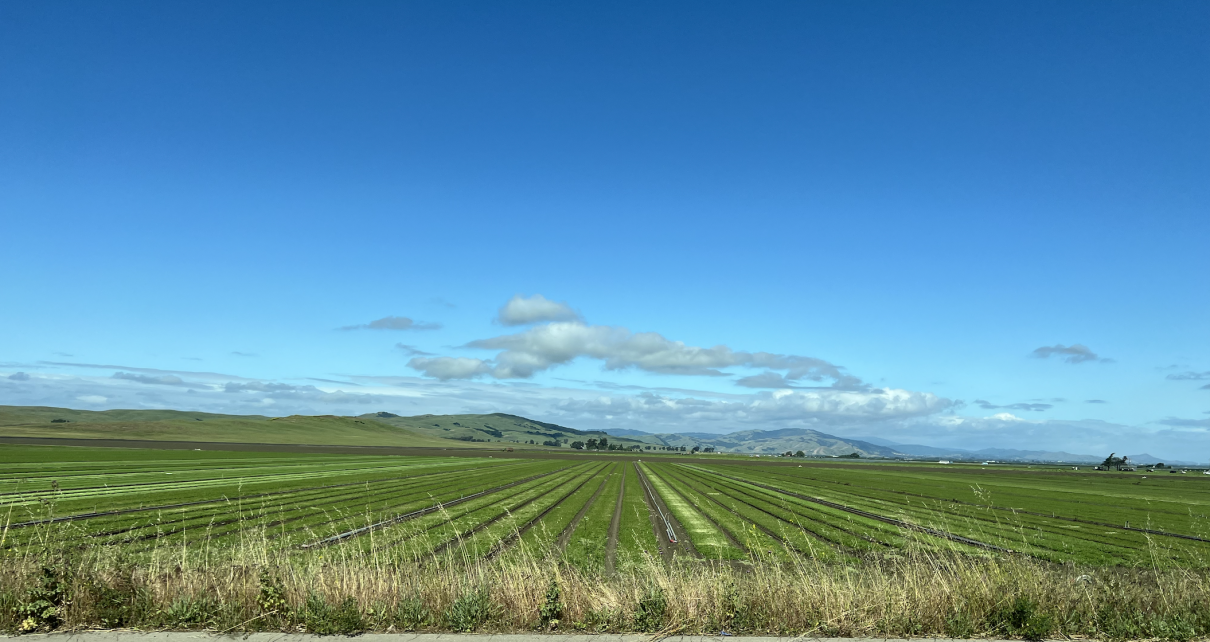
Beautiful California agriculture. (Photo: Katy Grimes for California Globe)
Tailpipes and Chimneys Greening Gardens and Forests
As CO2 concentrations rise, the water requirement for many plants decreases, making them more tolerant of drought
By Vijay Jayaraj, November 18, 2024 2:45 am
A farmer in South Korea’s Gyeongbok Province carefully tends to his potato field, while halfway across the world the engines of a thousand cars idle on an American interstate highway. These seemingly disconnected scenes share a bond through the fertilization effect of atmospheric carbon dioxide, which has been greening the Earth for decades.
Yes, the CO2 effluent of tailpipes and industrial flues are good for plants and all of life, contrary to the alarming tales that make this invisible gas an environmental bogeyman. Increasing CO2 concentrations are literally making the world greener, and in many cases, it’s sending crop production to record levels.
A 2020 study, funded by Cooperative Research Program for Agriculture Science & Technology Development, reported that potatoes grown in an atmosphere of elevated CO2—similar to what might be expected in coming decades—didn’t just survive but thrived!
The plants yielded a “distinct increase in growth and development and canopy net photosynthetic rate during tuber initiation and bulking. Consequently, biomass and canopy net photosynthesis increased, and tuber yield increased by 20.3%,” the researchers wrote.
This isn’t just good news for potato farmers. The CO2 fertilization effect plays a role in the photosynthesis of all plants, and an increase in the gas acts as a kind of turbo boost. Significant increases in yields are seen in wheat, rice, soybeans and maize—all staple crops that feed billions.
As CO2 concentrations rise, the water requirement for many plants decreases, making them more tolerant of drought – a scourge of farmers for millennia.
In the U.S. too, agriculture has flourished because of the additional CO2 in the atmosphere, including in the agricultural heartland of Midwest. As the data analysis in the CO2 Coalition’s report on the Midwest shows, it is very clear that a warming climate and the atmosphere’s carbon dioxide composition are increasing crop yields in the Midwest’s corn and soybean regions.
As Americans contribute roughly 14 metric tons of carbon dioxide per person annually, those emissions are fertilizing crops across the globe.
The greening effect extends far beyond agriculture. Satellite data from NASA has attributed the increased greenness over the past 35 years to the combined impact of elevated CO2 levels and optimal temperatures for plant growth.
The rising emissions of China and India from their increased use of fossil fuels have contributed significantly to this global greening and has benefited ambitious tree-planting programs and intensive agriculture. Certain countries in Europe have registered an increase in forest area as well. In fact, “36 countries are gaining more trees than they’re losing,” reports the World Resources Institute.
In fact, the rate of greening due to CO2 will be much higher than the rate of browning from the expansion of arid landscapes. Researchers at a Chinese university say that “by the end of this century, drylands will expand slightly by approximately 5%, while vegetation productivity will increase by about 50%.” Elevated CO2 impedes the expansion of drylands and “greatly promotes vegetation growth with increases in both leaf assimilation and canopy foliage,” they say.
Dr. Indur Goklany reports that 70% of Earth’s recent greening is attributed to emissions from the combustion of fossil fuels and that “fossil fuel dependent technologies have increased agricultural yields directly or indirectly by at least 167%.”
Whether it’s the tomato plants of Europe or the tropical forests in India, it’s clear that CO2-enriched air is greening the planet, and we as a society have been positive contributors to that. You might say that CO2 is the green energy for plant life.
- U.S. Energy Shift Offers Economic Hope to Global South - October 17, 2025
- India’s Ethanol Gambit: A Muddled Climate Policy - September 22, 2025
- Hanoi’s ‘Green’ Path to Poverty and Blackouts - September 2, 2025




Thank you! Many people are unaware of how low our atmospheric carbon levels have been -and getting lower for millions of years. I believe 180ppm is the floor where plant life begins to fail.
Volstock ice cores also showed that the atmospheric carbon levels have been as high as 22,000ppm . The good news in this article has been suppressed by many because it doesn’t fit their favorite narrative. May the honest Scientific Method return!
Kudos to the Globe for running stories based on actual Science.